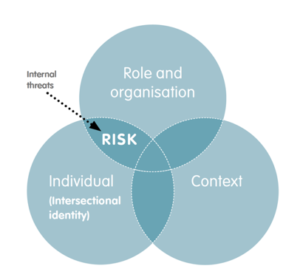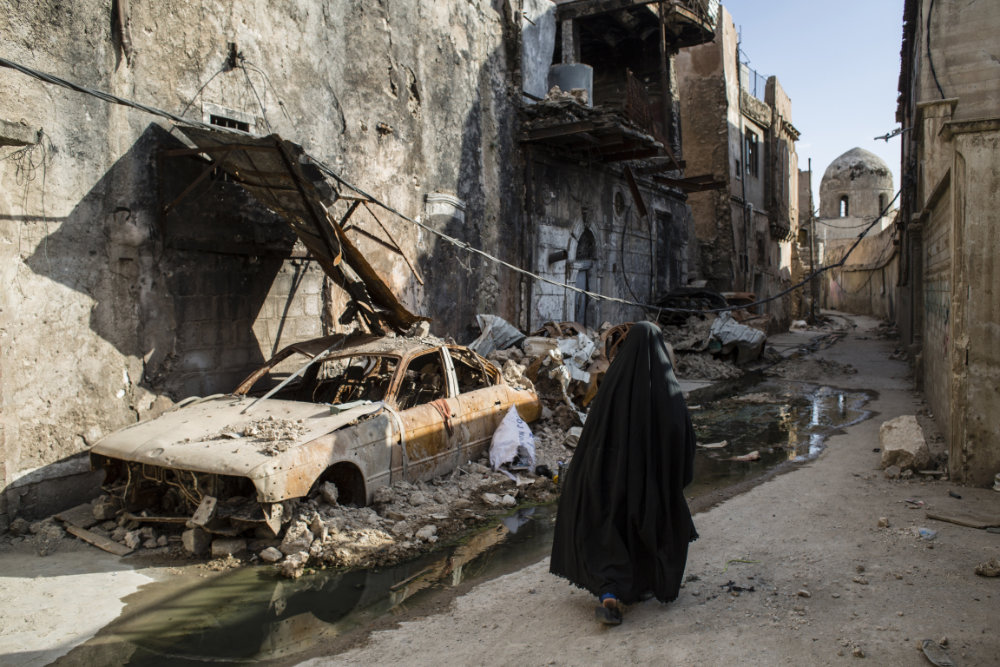Within the aid sector, there are survivors of racism, discrimination, harassment, rape, and exclusion, and they are from different sexes, genders, races, and physical and cognitive abilities. Aid organisations’ security risk management systems need to start considering how the diversity of their staff can affect the threats they may face from colleagues and put in place measures to prevent and address these internal security threats.
Diversity in risk
All aid workers have a personal profile that is made up of a number of personal characteristics. These characteristics intersect and result in what is often described as ‘intersectional identity’. That is, women and men are not defined only by their biological sex, but also by their sexual orientation, their race and their ethnicity, among other characteristics.
This intersectional identity interplays with an individual’s organisation and role, as well as the context in which they work. This interplay has implications for an aid worker’s security, including the security risks that may arise from internal threats.
Adopting this holistic approach to identity and risk allows decision-makers to understand how an aid worker’s identity and ability can affect their power and choice—thereby shaping their work and life experiences
It can be particularly insightful for understanding how identity plays a role in influencing vulnerability and exposure to internal threats from colleagues.
Internal threats
Minority profiles—such as staff with disabilities, minority ethnicities or races and those who identify as LGBTQI—are most at risk. Aid workers who contributed to EISF’s new research paper on diversity and security and who identified as LGBTQI or as a person with a disability reported feeling more concerned about internal threats than external threats to their security.
At my organisation, we always have a morning devotional. As a Christian, this is something I deeply value. However, on a number of occasions in devotionals, colleagues have insisted on highlighting passages in the Bible that speak about homosexuality as a sin. On at least two occasions this spiralled into a hate-filled rhetoric about gay people. As a gay man, I am constantly reminded why I have to keep my sexuality a secret.
Aid worker, Faith-based NGO, Middle East (EISF’s research paper excerpt)
Aid workers who contributed to EISF’s research stated that they sometimes felt unable to voice security concerns that relate to their personal characteristics for fear of discrimination.LGBTQI staff within faith-based organisations consistently reported that they fear being open about their sexuality with colleagues.
National staff are particularly vulnerable to specific threats, including bullying and blackmail, when their personal characteristics are not accepted in their home cultures. Research by the Feinstein Centre has uncovered examples where national homosexual staff are subjected to ‘sexual blackmail’ and ‘corrective rape’.
Internal threats can cause severe and immediate damage to individual aid workers, with long-term implications for both the individual and their employer. Organisations must address internal threats to meet their ethical and legal duty of care obligations towards staff.
Failing to address internal threats
Contributors to EISF’s research on diversity and security stated that discrimination and harassment go unreported when organisations do not have adequate policies and processes in place to report and address internal threats. This underreporting is particularly the case when the threat relates to personal characteristics and the organisational culture is not inclusive.
Human resources (HR) teams reported that security incidents perpetrated by staff against colleagues are often dealt with on an ad hoc basis and without following the correct procedures. Whether the incident is dealt with at all may depend on how empathetic senior managers are to the vulnerabilities of the individual affected.
When an incident is not dealt with appropriately, the perpetrator may assume it is acceptable to continue to behave in this way, thereby perpetuating an organisational culture that is hostile towards particular personal profiles. There is a risk that in such environment incidents will grow in frequency and severity.
Inclusive security risk management
Based on the findings of its research, EISF has introduced the term ‘inclusive security risk management’, which aims to allow decision-makers to apply a diversity lens to standard security risk management policies and practices. The aim is to ensure that organisations meet their privacy and non-discrimination responsibilities in addition to their duty of care obligations.
Key to this inclusive process is to account for internal security threats that are motivated by hostility towards particular profiles. At the most fundamental level, organisations should address organisational culture and develop appropriate reporting mechanisms.
Culture
Many incidents perpetrated by aid workers against colleagues can be traced back to culture; whether that is organisational culture or the culture of the local context. How certain identity characteristics are ‘defined’ in the work and living environment can influence the behaviour that is perceived as acceptable towards individuals with these characteristics, particularly if they are restricted in their relative power and choice.
The Feinstein Centre’s research highlights, for example, that many aid organisations suffer from a ‘pervasive anti-gay and homophobic employee work and living atmosphere’. EISF’s research has found that this culture can be compounded by local perceptions of and behaviour towards particular profiles, which contribute to the establishment of an internal ‘enabling environment’ for perpetrators.
Changing culture is not easy. Some organisations focus on addressing the culture of the local context when this is part of their mandate. However, all organisations—whatever their mandate—should be promoting an inclusive organisational culture. Decision-makers within organisations can start by ensuring that victimisation, discrimination and any other form of harm against fellow aid workers are dealt with appropriately and with proportionate severity in accordance with policy and legislation. EISF’s research has also found that having open discussions about perceptions and bias towards particular profiles can help tackle hostile cultural attitudes in the workplace.
Reporting mechanisms
Incident reporting and monitoring is the best way to ensure that staff who experience internal threats due to their personal profile receive the support they need. It is also an essential way for managers, HR and security staff to prevent future incidents.
Unfortunately, the #AidToo movement has demonstrated the weaknesses of a number of organisational reporting systems. Contributors to EISF’s research voiced a lack of trust in aid organisations’ HR systems and security teams, and questioned the efficacy of organisational reporting mechanisms. 20% of aid workers surveyed by EISF reported that they would not know when or how to report an incident. Only 53% trusted that an incident report would be handled sensitively and with their consultation.
Robust and confidential reporting and whistleblowing systems are essential, especially when it comes to internal threats that arise due to an aid worker’s personal profile. Reporting systems should allow individuals to report concerns or incidents through several culturally-appropriate and accessible channels. Several different members of staff should receive these reports. It may make sense to have an online reporting system (such as that used by World Vision) or employ an external whistleblowing service provider.
Staff would benefit from being made aware of the reporting process at induction and regularly thereafter. This should entail informing the staff of what happens upon reporting, including who will access the information and how the reporter will be notified of any actions taken.
Organisations can also conduct an anonymous survey to understand the scale and nature of incidents that have not previously been reported by staff. Harassment cases that individuals may not want to report can be indicative of an underlying culture that can eventually lead to more severe incidents if not tackled.
***
The #AidToo movement has shone a much-needed spotlight on the shortcomings of the aid sector when it comes to dealing with threats that emanate from within. However, we cannot forget that aid workers themselves can be the victims of these internal threats and that their identity can affect the risks they face. The problem is much broader than sexual violence and violence against women, and it requires a more comprehensive solution.
***
To learn more about diversity and risk, including what an inclusive security risk management framework comprises, see EISF’s full research paper Managing the Security of Aid Workers with Diverse Profiles.
***
Adelicia Fairbanks is a Research Advisor at EISF.
DISCLAIMER: Posts and discussion on the Humanitarian Law & Policy blog may not be interpreted as positioning the ICRC in any way, nor does the blog’s content amount to formal policy or doctrine, unless specifically indicated.








http://www.csend.org/images/articles/files/20081124-ICRC_stress_delegate.pdf
Thank you Adelicia, especially for your insisting that one’s identity is a multi-layered story. It therefore offers various vulnerability spots.
On the other hand, I am a bit worried imagining all it will take to adopt to create a real inclusive workforce. I guess we will need to tackle several aspects at once.
For example we could use Ken Wilber’s model (my interpretation): looking at an issue from 4 perspectives: the I (the subject), the We (people around -support groups – culture), the It (the issue / definition of inclusion) and the Its (the legal etc. structures around this).
Best regards, Daniel